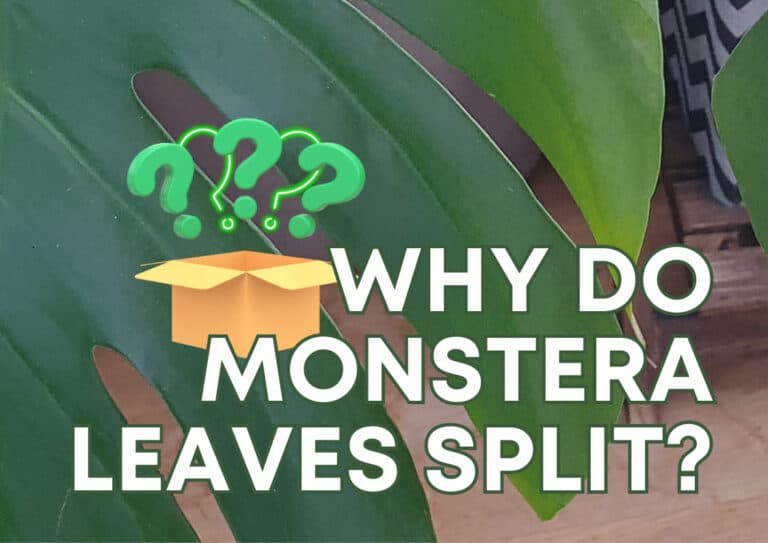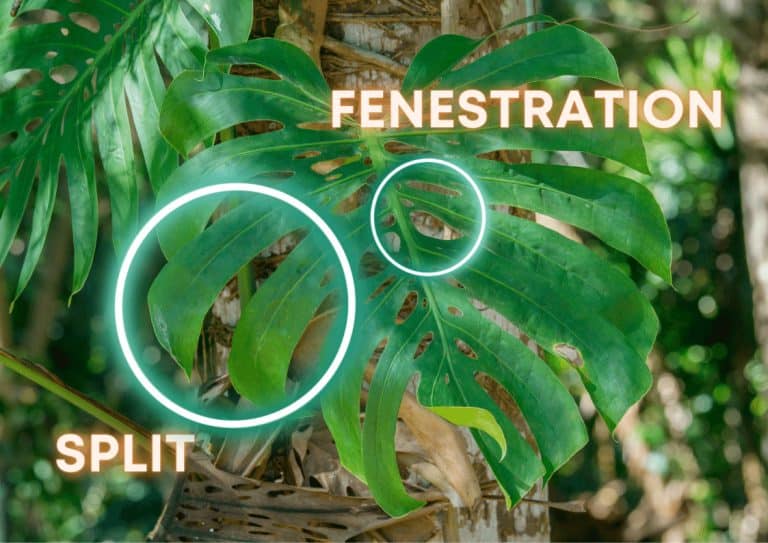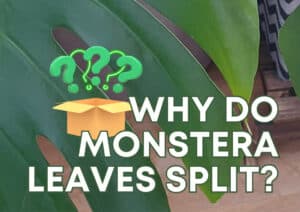Solving The Puzzle Of Why Monstera Leaves Split
-
Chris Dosser
- March 24, 2023
If you buy something using the retail links in our articles, sometimes we earn a small affiliate commission. This does not impact the products we recommend.
Monstera plants are extremely popular for their unique appearance. This genus boasts beautifully split leaves that create a lovely, verdant appearance in any living space. It can feel like bringing an authentic piece of a tropical forest into your home! But what exactly is it that causes those signature split leaves? Do they serve any purpose?
From a cell biology standpoint splitting in Monstera is caused by programmed cell death when the leaf is in its developmental stage and before it unfurls.
There is currently no scientific consensus on why monstera leaves split, however there are several credible theories such as splits allowing sunlight to pass to lower sets of leaves, improving nutrient regulation and increasing wind resistance, each of which would potentially provide an evolutionary benefit to Monstera plants growing in the wild.
Understanding how and why Monstera leaves split might not be necessary for ownership of this plant, but it can be useful and interesting information! So in this article, we’ll examine each of the leading leaf splitting theories in more detail.

What is the scientific process behind the splitting of Monstera leaves?
Monstera leaves split through a process called early programmed cell death. Essentially, this means that splits and holes in leaves are a natural, biologically process. They develop automatically in new leaves when a Monstera plant reaches a specific stage of growth and is provided with optimal growing conditions.
During this process, leaves begin to develop small but distinct patches where cells slowly die off. This creates holes in the leaves, just about the size of a pinprick. Over time, as the leaf develops the holes grow and extend outward, reaching sizes 10,000 times their original diameter. Eventually, in some of the Monstera genus the holes lengthen across the leaf, reaching the perimeter and cause the leaf to split.
You can’t change or control whether holes and splits appear in each species of the Monstera genus. That’s determined solely by genetics, so when choosing a Monstera for your home, you should first check the kinds of patterns each species displays so you can pick the one you like best.
Not all of the 59 Monstera species develop splits or fenestrations. And for those that do split, if growing conditions are sub-optimal plants can take months to generate their first decorative leaves, and even longer to incorporate fenestrations.

Why do Monstera leaves split?
As previously mentioned, there is no confirmed scientific consensus behind the process of Monstera leaf splits. However, there are several credible theories that may explain the mysteries behind this beautiful yet mysterious programmed development.
Stretching to access sunlight
The first theory is the most common, stating that Monstera leaves split to improve sunlight absorption and access. Monstera leaves need as much light as they can get, but in the wild, they may be shielded beneath the canopies of taller trees and may therefore be unable to get that much sun.
To get more sun, plants have to increase the surface area of their leaves, so more parts of them can catch rays and perform photosynthesis. Monstera plants can expand their reach through splits. When done with splits, they don’t need to produce additional leaf tissue, thereby preventing excessive energy use.
Our Favorite Monstera Plants And Supplies On Etsy
Redistributing resources
There is also a theory that the holes and splits in Monstera leaves develop to allow resources through to lower leaves, especially water, and moisture. Through the holes, water can pass and reach roots and new, young leaves beneath larger, mature leaves. It’s also theorized that this improves sunlight access, allowing lower leaves to soak up the sun’s rays.
On the surface, this theory holds plenty of water, pun intended. Because Monstera plants grow in the undergrowth in the wild, rain may get blocked out by the many taller trees above them, thus requiring adaptations for the sufficient absorption of moisture. Larger leaves can also prevent excessive loss of moisture.
Regulating growth rate
It is also possible that Monstera plants develop leaf splits to reduce variations in growth rate. This is because a plant doesn’t begin to produce leaves with splits until a certain point of growth and maturity is reached, thus allowing the plant to become robust before pushing for further growth.
Wind resistance
Some less plausible but still possible theories also exist beyond these concepts. Some experts believe that split leaves allow for increased wind resistance, preventing leaves from tearing in high winds. Another theory is that split leaves improve camouflage, protecting Monstera plants from herbivores. Holes in leaves can also look less appetizing to animals that consume plants.
Temperature regulation
Finally, it’s a rare but plausible theory that larger leaf area, facilitated by leaf splits, can help temperature regulation. Splits and holes in leaves can help circulation and turbulence. However, rainforests don’t typically get very hot, so this might only be a minor benefit as opposed to a direct cause of the splits in Monstera leaves.
Why are my Monstera’s leaves not splitting?
To develop split leaves, a Monstera plant has to reach a certain level of maturity and growth – presuming your Monstera is a species that does in fact develop splits.
In Monstera deliciosa splits don’t develop until a plant has produced at least 5 leaves. Then certain conditions must be met before a Monstera decides it is time to kick off programmed cell death and split.
When they’re still young, Monstera plants won’t benefit from any of the potential reasons for splitting. For example, if it is indeed sunlight distribution that they split for, then smaller leaves have no reason to split, as they don’t really block out any sun. Or, if leaves split to appear less appetizing or interesting to herbivores, well, herbivores are rarely interested in young, small leaves anyway.
But if your Monstera plant’s leaves are still not splitting despite reaching a certain point of maturity, chances are that the problem lies in insufficient care. Though they’re relatively easy to care for, Monsteras can be quite picky about their needs, and they are unlikely to grow well if any of their needs are not met.
A lack of sunlight is the most common reason that a Monstera’s leaves are not splitting. Bright indirect light is important for Monstera plants, and most cannot reach sufficient growth at low light levels. If only some of your plant’s leaves are splitting, then chances are that the plant needs to be rotated, so all sides receive sufficient light.
Other common issues include a lack of sufficient water or nutrients. You may need to increase watering frequency or amount but do so with care, as overwatering can quickly cause root rot. For extra nutrients, you can use fertilizer to encourage growth.
Before you go…
We still don’t know for sure why Monstera leaves split, but the available theories, as put forward by experts in the field, are all quite plausible.
Mostly likely seems to be the hypothesis that they may split to increase leaf surface area without needing to expend resources on tissue growth. This can improve their ability to reach untapped sources of sunlight or moisture, and it may help with temperature regulation.
Splits in leaves may also develop to promote better airflow preventing wind damage by allowing circulation through the splits. These splits and holes may also allow lower leaves on a Monstera to get sunlight and moisture from above. Split leaves may also reduce the risk of a plant’s leaves being consumed by herbivores.

Chris Dosser
Co-Founder of Eden Indoors
Chris is a self-taught horticulturist with over a decade of experience caring for houseplants and creating lush, thriving indoor oases. He specializes in Monstera, and by self admission has a serious problem with buying and propagating rare indoor plants!
Similar Posts
Solving The Puzzle Of Why Monstera Leaves Split
Monstera plants are known for their beautiful split leaves, but why do their leaves develop this unique signature feature in the first place?
Monstera Leaves Yellowing After Repotting: Causes and Solutions
Yellowing leaves may be a sign that your Monstera is experiencing shock or stress, but is this caused by overwatering, underwatering or nutrient deficiencies?



